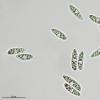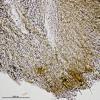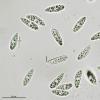
17-09-2025 10:50
Heather MerryleesHi there!I am hoping for any advice on the identif

27-11-2025 15:41
Thomas LÌssøeSpores brownish, typically 4-celled; 26.8 x 2.4;

27-11-2025 12:01
Thomas LÌssøehttps://svampe.databasen.org/observations/10496727

27-11-2025 11:46
Thomas LÌssøehttps://svampe.databasen.org/observations/10493918

27-11-2025 11:31
Thomas LÌssøeCollectors notes: Immersed ascomata, erumpent thro

23-09-2025 13:31
Thomas LÌssøehttps://svampe.databasen.org/observations/10534623

25-11-2025 14:24
Thomas LÌssøehttps://svampe.databasen.org/observations/10490522

26-11-2025 18:13
The entire run of Mycotaxon is now available throu
Hymenoscyphus laetus
Miguel Ăngel Ribes,
18-03-2011 10:32
 Good morning
Good morningThis Hymenoscyphus is from Fuente del Paco, Huesca, Pyrenees, in a mixed forest of Fagus sylvaticus and Abies alba, 2-4 mm broad.
Spores (1000x, water, fresh material)
(13.4) 14.9 - 18.0 (23.9) x (3.9) 4.5 - 5.4 (5.8) Âľm
Q = (2.6) 2.9 - 3.8 (4.8) ; N = 67
Me = 16.5 x 4.9 Âľm ; Qe = 3.4
Are you agree with H. laetus?
Thank you.
Miguel Ă. Ribes
Miguel Ăngel Ribes,
18-03-2011 10:33
Miguel Ăngel Ribes,
18-03-2011 10:36
Hans-Otto Baral,
18-03-2011 14:23

Re:Hymenoscyphus laetus
Did you find this in autumn? The substrate would be interesting: Abies and Fagus are easily distiinguished when breaking the twig (Fagus with distinct radial rays).
This is H. calyculus. H. laetus has very short stipes and the spores are completely homopolar (the spores on your pic have an upper and lower end, though not very distinct: slightly scutuloid).
Zotto
This is H. calyculus. H. laetus has very short stipes and the spores are completely homopolar (the spores on your pic have an upper and lower end, though not very distinct: slightly scutuloid).
Zotto
Miguel Ăngel Ribes,
18-03-2011 14:41
Hans-Otto Baral,
18-03-2011 22:27

Re:Hymenoscyphus laetus
yes, that's fine! And also the sheath bis visible here that detaches from the spores.
H. laetus is restricted to calcareous rivulets where it grows on wet wood lying for a long time in the running but shallow water.
Zotto
H. laetus is restricted to calcareous rivulets where it grows on wet wood lying for a long time in the running but shallow water.
Zotto
RaĂşl Tena Lahoz,
19-03-2011 19:10

Re:Hymenoscyphus laetus
Hi Miguel Ăngel & Zotto
Here two links with my pics about Hymenoscyphus laetus:
https://picasaweb.google.com/raultenalahoz/20101004HymenoscyphusLaetusPitarque?authkey=Gv1sRgCL2azsT2nub81QE&feat=directlink
https://picasaweb.google.com/raultenalahoz/LaetusPitarque?authkey=Gv1sRgCNLw2_qprur3Zg&feat=directlink
But I saw a strange reaction in some tips of the asci. Not all reacted like that but it was striking to see some half red-half blue! Maybe due to the soaked habitat?
Also some carotenoids guttules in subhymenium.
RaĂşl
Here two links with my pics about Hymenoscyphus laetus:
https://picasaweb.google.com/raultenalahoz/20101004HymenoscyphusLaetusPitarque?authkey=Gv1sRgCL2azsT2nub81QE&feat=directlink
https://picasaweb.google.com/raultenalahoz/LaetusPitarque?authkey=Gv1sRgCNLw2_qprur3Zg&feat=directlink
But I saw a strange reaction in some tips of the asci. Not all reacted like that but it was striking to see some half red-half blue! Maybe due to the soaked habitat?
Also some carotenoids guttules in subhymenium.
RaĂşl
Hans-Otto Baral,
19-03-2011 23:14

Re:Hymenoscyphus laetus
ah, you see the upper ring reddish. Did you also test KOH-pretreatment? Maybe the upper ring turns then also blue?
I must correct myself, I think Miguels colection is H. subferrugineus. I once thought that H. calyculus is frequent, but I actually did not see it for a long time. It has larger spores with larger LBs inside, but I admit the distinction to subferrugineus is not really clear.
Zott
I must correct myself, I think Miguels colection is H. subferrugineus. I once thought that H. calyculus is frequent, but I actually did not see it for a long time. It has larger spores with larger LBs inside, but I admit the distinction to subferrugineus is not really clear.
Zott
RaĂşl Tena Lahoz,
20-03-2011 15:05

Re:Hymenoscyphus laetus
Thanks Zotto
Yes, the upper ring red (hemiamyloid) and more down blue (euamyloid). Not tested KOH-pretreatment. I will check it when I get it again (I think it is common in my area).
Should I see then (after KOH-pretreatment) two types of blue if it is an hemiamyloid reaction? If upper part remains unstained (also after KOH-pretreatment, as in the attached image), then no hemiamyloid reaction?, so red colour is maybe then because of my IKI composition?
I attach an image of Hymenoscyphus caudatus asci (find on Populus nigra leaves) in IKI after KOH-pretreatment.
RaĂşl
Yes, the upper ring red (hemiamyloid) and more down blue (euamyloid). Not tested KOH-pretreatment. I will check it when I get it again (I think it is common in my area).
Should I see then (after KOH-pretreatment) two types of blue if it is an hemiamyloid reaction? If upper part remains unstained (also after KOH-pretreatment, as in the attached image), then no hemiamyloid reaction?, so red colour is maybe then because of my IKI composition?
I attach an image of Hymenoscyphus caudatus asci (find on Populus nigra leaves) in IKI after KOH-pretreatment.
RaĂşl
Hans-Otto Baral,
20-03-2011 17:59

Re:Hymenoscyphus laetus
I rarely saw such differences between blue and red in a single ring. If so, this diference will change to uniformly blue after KOH. If the upper ring does not get blue thereby, it s something else I do not understand.
Zotto
Zotto
RaĂşl Tena Lahoz,
20-03-2011 18:42

Re:Hymenoscyphus laetus
Ok, thanks again.
RaĂşl
RaĂşl
Miguel Ăngel Ribes,
21-03-2011 00:58

Re:Hymenoscyphus laetus
Hi Zotto, RaĂşl
I did not picked up this collection, but I know the place, and it is not so wet like Raul's collection of H. laetus.
I think spores of my collection are closer to your plates of H. subferrugineus than H. calyculus, thank you Zotto, so H. subferrugineus, by the moment.
Thank you,
I did not picked up this collection, but I know the place, and it is not so wet like Raul's collection of H. laetus.
I think spores of my collection are closer to your plates of H. subferrugineus than H. calyculus, thank you Zotto, so H. subferrugineus, by the moment.
Thank you,







